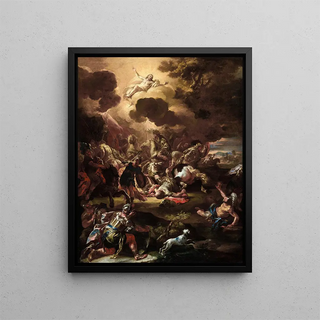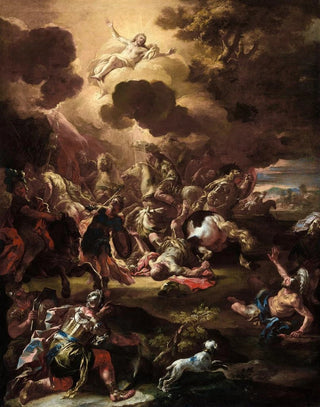Art print | The Conversion of Saul - Francesco Solimena


View from behind

Frame (optional)
Art print La conversion de Saül - Francesco Solimena – Engaging Introduction
At the heart of Baroque art history, the artwork "La conversion de Saül" by Francesco Solimena stands out for its dramatic intensity and spiritual depth. This iconic painting depicts a pivotal moment in the transformation of Saül, the future apostle Paul, as he is struck by a celestial light on the road to Damascus. The scene, charged with emotion, captures the precise instant when Saül's life changes forever, revealing the tensions between the divine and the human. The art print of this masterpiece, while preserving the richness of colors and details, allows art enthusiasts to immerse themselves in this Baroque universe, where every brushstroke tells a story.
Style and uniqueness of the work
Solimena's style is characterized by an unparalleled mastery of chiaroscuro, which brings his characters and their emotions to life. In "La conversion de Saül," light plays a crucial role, illuminating Saül's face while casting the rest of the scene into suggestive shadow. This manipulation of light creates an atmosphere that is both mystical and dramatic, emphasizing the shock of divine revelation. The figures, dynamic and expressive, are rendered with striking realism, demonstrating the artist's technical skill. The drapery, heavy yet fluid, adds a tactile dimension to the composition, while the vibrant and contrasting color palette enhances the visual impact of the artwork. Every element, from the horse to Saül's escort, contributes to the scene's intensity, making this piece a true ode to spirituality.
The artist and his influence
Francesco Solimena, born in 1657 in Canosa di Puglia, is a major figure of Neapolitan Baroque. His artistic journey is marked by a constant pursuit of emotion and visual storytelling. Influenced by masters such as Caravaggio and the artists of the Neapolitan school, Solimena developed a personal style that combines Baroque dramatization with a softer, lyrical approach. His works, often rich in religious themes, reflect a deep contemplation on the human condition and the

Matte finish

View from behind

Frame (optional)
Art print La conversion de Saül - Francesco Solimena – Engaging Introduction
At the heart of Baroque art history, the artwork "La conversion de Saül" by Francesco Solimena stands out for its dramatic intensity and spiritual depth. This iconic painting depicts a pivotal moment in the transformation of Saül, the future apostle Paul, as he is struck by a celestial light on the road to Damascus. The scene, charged with emotion, captures the precise instant when Saül's life changes forever, revealing the tensions between the divine and the human. The art print of this masterpiece, while preserving the richness of colors and details, allows art enthusiasts to immerse themselves in this Baroque universe, where every brushstroke tells a story.
Style and uniqueness of the work
Solimena's style is characterized by an unparalleled mastery of chiaroscuro, which brings his characters and their emotions to life. In "La conversion de Saül," light plays a crucial role, illuminating Saül's face while casting the rest of the scene into suggestive shadow. This manipulation of light creates an atmosphere that is both mystical and dramatic, emphasizing the shock of divine revelation. The figures, dynamic and expressive, are rendered with striking realism, demonstrating the artist's technical skill. The drapery, heavy yet fluid, adds a tactile dimension to the composition, while the vibrant and contrasting color palette enhances the visual impact of the artwork. Every element, from the horse to Saül's escort, contributes to the scene's intensity, making this piece a true ode to spirituality.
The artist and his influence
Francesco Solimena, born in 1657 in Canosa di Puglia, is a major figure of Neapolitan Baroque. His artistic journey is marked by a constant pursuit of emotion and visual storytelling. Influenced by masters such as Caravaggio and the artists of the Neapolitan school, Solimena developed a personal style that combines Baroque dramatization with a softer, lyrical approach. His works, often rich in religious themes, reflect a deep contemplation on the human condition and the






